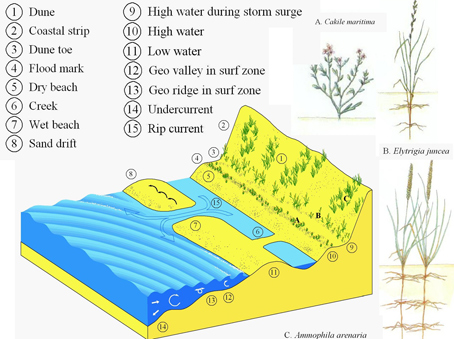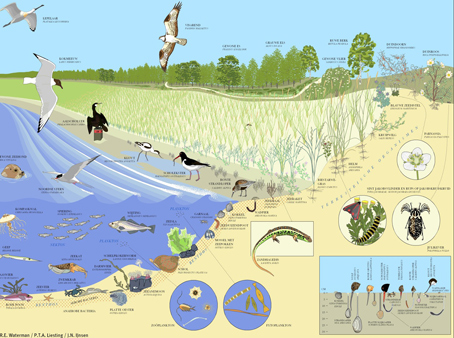Where nature allows it, the principle of Building with Nature should be applied as much as possible in the realisation of new land. The essence of this principle is: flexible integration of land-in-sea and of water-in-the-new-land, making use of Materials, Forces & Interactions present in nature, taking into account existing and potential nature values, and the Bio-geomorphology & Geo-hydrology of the coast and seabed.
Materials
These include: loose mobile material sand and silt (varying in size, structure and composition) and the forces & interactions to which they are exposed.

Forces & Interactions
• Tidal action (ebb & flood);
• Wave action (specifically in the breaker zone) and swell action;
• Sea currents other than tidal currents;
• River outflow (as force and as supplier of freshwater and sediment);
• Gravity;
• Wind;
• Rain;
• Solar radiation;
• Interaction dunes-vegetation (root systems of the vegetation hold together sand and silt); Interaction coastal zone-mangroves;
• Complex interaction between marine organisms and sand/silt/clay particles in beach and near shore.
Bio-geomorphology & Geo-hydrology of coast and seabed
Attention should be given to the type and shape of the coast under consideration, its bio-geomorphological history and the geo-hydrology of coast & seabed.
Dynamic equilibrium coastline
Regarding the land reclamation application, the method of Building with Nature should be emphasized, both from the viewpoint of nature as from a viewpoint of cost-effectiveness. Human activities should be incorporated as much as possible in the system of natural cycles. The emphasis is on sustainable development in densely populated coastal and delta areas. In this method a new flexible, dynamic equilibrium coastline is created using sand from the sea, consisting of a new primary range of dunes with a new beach in front and with a minimum of solid sea-wall elements. The emphasis is no longer on inflexible solid bulwarks against the sea, like dams & dykes, but instead on flexible soft structures in harmony with the sea, like dunes & beaches. In the new flexible dynamic equilibrium coastline accretion and erosion are more or less balancing each other, with a limited maintenance factor through periodic beach nourishment. Only in those places where erosion strongly dominates accretion solid seawall elements are applied.
The overall principle is applicable in many of the world’s coastal regions and has been applied with success, adapted to local situations. The method takes into account all the forces and interactions acting on the loose mobile material sand and silt, being the action of tides, waves (specifically in the breaking zone), swell, river outflow (as force and as a source of fresh water and sediment), estuarine and ocean currents, gravity, wind, rain and solar radiation, seeing to it that the net resulting force acting on the sand/silt – averaged in time – is relatively small. Use is also made of the interaction vegetation-sand.
Another factor to be considered is the complex interaction between marine organisms and sand/silt/clay particles in beach and near shore. In all cases the bio-geomorphology & geo-hydrology of the region, referring to coast and seabed have to be considered.

Building with Nature also takes into account the present geomorphology and the historic development of these coastal and delta areas, soil & subsoil characteristics, land subsidence, plate tectonics, marine/river & terrestrial environment, monera & protista, flora & fauna, ecosystems, climate & climate change with all its implications like sea-level rise, higher frequency and intensity of storm surges and rainfall, as well as periods of drought. A low maintenance factor of the new coastline is taken into account, through periodic beach nourishment. Only in those cases where erosion is clearly and strongly dominating accretion, solid seawall elements are to be preferred, but only then. In those cases a marriage between soft and tough coastal defence can be realised, leading to a concave coastline between an existing soft coast and a solid seawall element or a concave coastline between two solid seawall elements.
To learn to know the full extend of the Building with Nature principle, view the Ronald Waterman presentation (total 270 MB).
